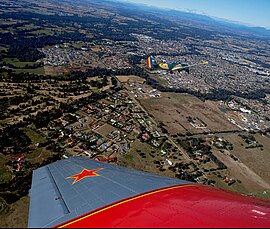Wangaratta, Victoria
Wangaratta is a city in the northeast of Victoria, Australia. About 19,000 people live there. It is about 230 km (140 mi) from Melbourne along the Hume Highway. The city of Benalla 45 km (28 mi) is to the south west, and Albury and Wodonga 72 km (45 mi) to the north east. The Ovens and King Rivers which flow from the Victorian Alps meet at Wangaratta. It is in the local government area of the Rural City of Wangaratta.
| Wangaratta Victoria | |||||||||
|---|---|---|---|---|---|---|---|---|---|
 Aerial view from the north-west, Hume Freeway bypass somewhere around top, One and Three Mile creeks meeting around the middle. | |||||||||
 | |||||||||
| Coordinates | 36°21′30″S 146°18′45″E / 36.35833°S 146.31250°E | ||||||||
| Population | 18,891 (2016) | ||||||||
| • Density | 327.97/km2 (849.4/sq mi) | ||||||||
| Area | 57.6 km2 (22.2 sq mi)[1] (2011 urban) | ||||||||
| Time zone | AEST (UTC+10) | ||||||||
| • Summer (DST) | AEST (UTC+11) | ||||||||
| Location | 250 km (155 mi) from Melbourne | ||||||||
| LGA(s) | Rural City of Wangaratta | ||||||||
| County | Moira, Delatite, Bogong | ||||||||
| State electorate(s) | Ovens Valley | ||||||||
| Federal division(s) | Indi | ||||||||
| |||||||||
History
changeGold was found in the area during the 1850s. A Post Office opened on 1 February 1843, as Ovens, and moved to the town and was renamed Wangaratta in 1854. The Ovens office, and the Kilmore office which opened the same day, were the fifth and sixth to open in the Port Phillip District (Victoria). They were also the first two inland offices.[2]
The small town of Glenrowan about 10 km away is known as the site of the final shootout that led to the capture of Australia's most famous bushranger, Ned Kelly.
References
change- ↑ "2011 Census Community Profiles: Wangaratta". ABS Census. Australian Bureau of Statistics. Archived from the original on 11 November 2017. Retrieved 15 September 2016.
- ↑ Premier Postal History, Post Office List, retrieved 2008-04-11
